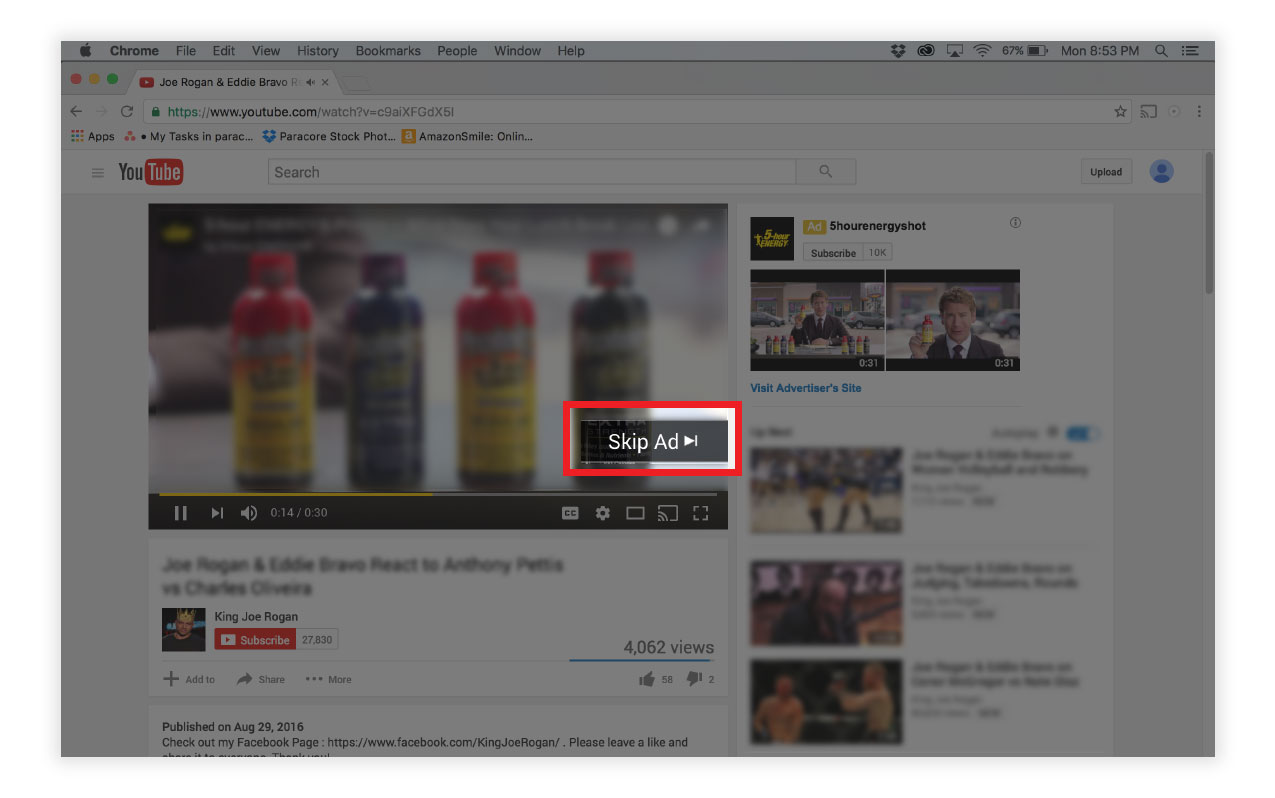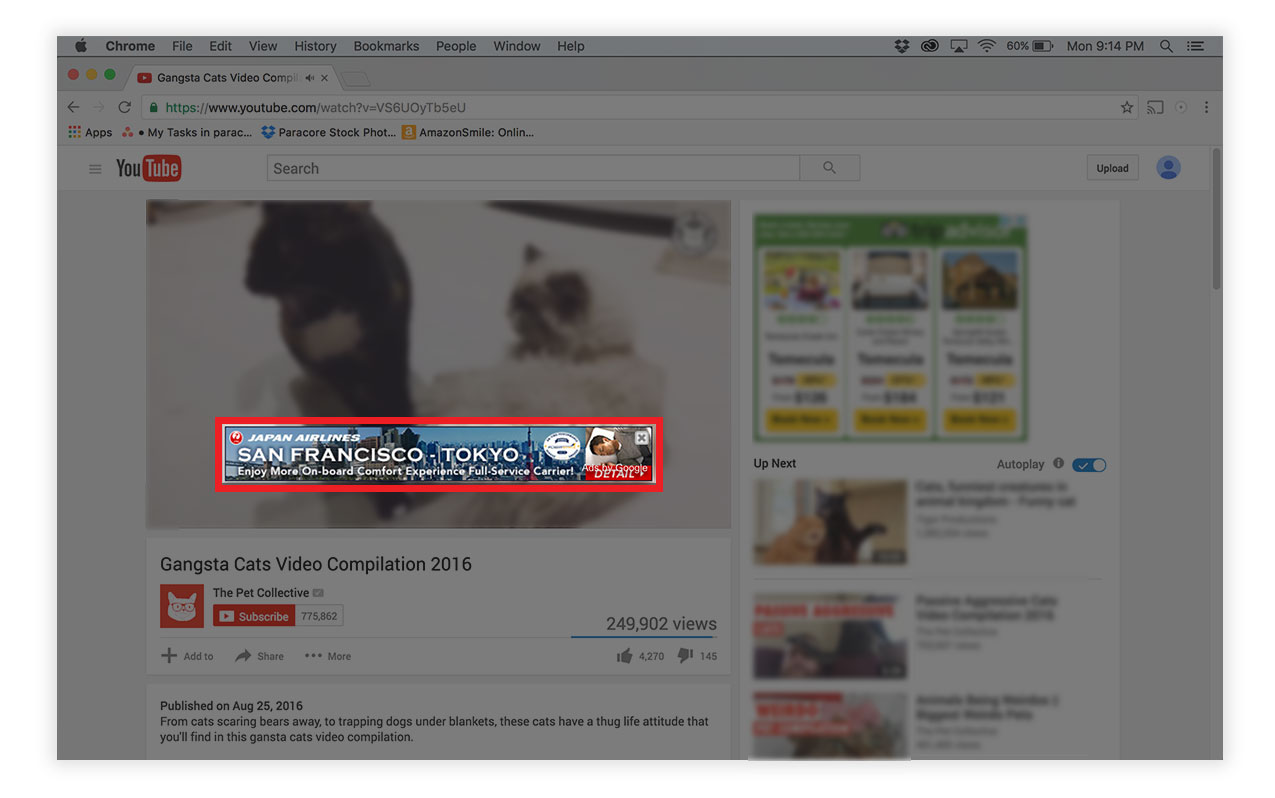On August 1, 1981, the entertainment world changed forever when MTV launched the first music-focused TV channel with a tongue-in-cheek song: “Video Killed the Radio Star.” The channel not only introduced the world to a whole new music medium, but also new, inexpensive opportunities for advertisers to reach a captive audience.
[flex_video]
[/flex_video]
The same thing is happening today.
There’s another platform transforming entertainment for consumers and advertising for businesses. Millions of people around the world are sitting in front of their screens watching hours of videos fueled by ads that relate to what they’re watching.
The ad cost-per-view is often under ten cents (we’ve seen it as low as four). And competition? Practically non-existent.
That’s YouTube.
It’s an often-overlooked platform for digital marketing, but the advantages of YouTube advertising are endless. Here’s how YouTube ads present a “killer” opportunity for businesses looking to expand their reach without breaking the bank.
Why YouTube ads offer a big bang for your buck
Since 2007, YouTube has been introducing new types of video marketing. The platform offers promising possibilities for advertisers for two main reasons:
- It’s incredibly popular with viewers, and
- It’s incredibly unpopular with advertisers.
YouTube is the second most visited site in the world behind Google, with roughly 8 out of 10 adults ages 18-49 visiting it on a daily basis. Like Facebook, YouTube is used by a huge percentage of the population, presenting tons of potential for advertising. And because Google owns it, YouTube’s audience targeting system is top-notch.
Many small- and mid-sized businesses are hesitant to try YouTube advertising because they think it takes a lot of work and resources to create videos. However, there are non-video formats that don’t require much work. Plus, those who do put the effort into creating ads are rewarded with ridiculously low advertising costs and engaged users.
“The supernova scene” of YouTube ad formats
YouTube offers a handful of ad types. And, believe it or not, they don’t all require making videos! Here are the YouTube ad formats to choose from:
Video ads
These are the ads you’re probably most familiar with. They run before the video you want to watch before it begins playing, or at intervals throughout longer videos.
When setting up the ad, you can choose to make it skippable or non-skippable. Skippable means the user can skip the ad and proceed to their video after 5 seconds. Non-skippable means they must watch the whole ad (up to 20 seconds) before their video plays.
In most situations, we suggest making the ads skippable. Viewers like having the choice to continue engaging with your ad or not, and forcing them to watch a 20-second commercial can cause frustration and negative feelings toward your brand.
Search result ads
If your company regularly publishes videos, using search result ads is a must. Like an AdWords listing, your video will appear at the top of the results when a user searches for a given phrase, which helps attract more traffic from people who are already looking for what you offer.
This ad format is ideal for videos that are engaging and provide value, while discreetly selling your product or service. Blendtec’s “Will It Blend?” series, for example, would be a prime candidate for search result ads.
Sponsored cards
Sponsored cards are useful when you’re promoting a product in your video. The “cards” are images that appear on the right side of the video and link to product landing pages, related videos, or even full video playlists.
Overlay ads
These display ads pop up over the bottom of your video screen. If your business doesn’t want to create video ads, overlay ads are a smart way to get in front of YouTube viewers without spending resources on production.
3 ways to know if YouTube advertising is “your second symphony”
YouTube can yield incredible results, but it’s not for everyone. Here are a few questions to help determine if YouTube is the right medium for your campaign.
1. Can you create videos?
Even simple videos can be effective if they’re created well. But is your business equipped to do it? Do you have someone who’s willing to be a spokesperson for your business, as well as a team member with video shooting and editing experience? If not, are you willing to invest in a videography partner?
2. Is your goal to attract impressions or clicks?
YouTube is great for developing brand and product awareness, especially when it’s a new solution that requires more explaining. But when it comes to collecting clicks, other digital marketing tactics may be more effective.
Consider the realty industry, for example. Most people will need a realtor at some point. However, the industry is very location-based, and the timing of their need is unpredictable. Plus, the chances of someone seeing a YouTube ad at the exact moment when they need to hire a realtor is quite low.
In this situation, a Google listing would be much more effective because it appears as soon as the user searches for a solution to their problem, which increases the likelihood of a click and conversion.
3. Are you integrating YouTube ads with a remarketing campaign?
While not required, remarketing is a great complement to YouTube ads.
Picture this: A viewer sees your product video play as they’re browsing YouTube. The ad appeals to them, but they’re excited about the video they originally searched for and forget about yours.
A few days later, they see an ad on Facebook for your product again. It triggers their memory of the YouTube video, and they click through to make a purchase. This is just one way YouTube ads have an exponential impact when they’re used as part of a larger digital marketing campaign.
How to create ads that will make users “intent on tuning in on you”
Think YouTube ads are right for your business? Here are a few tips to keep in mind as you work on your video:
- Keep the videos specific. As the saying goes, “When you try to please everyone, you end up pleasing no one.” Instead of making your ad about your entire line of products or services, focus on just one thing to connect with viewers who need exactly what you offer.
- Use annotations. YouTube offers a series of post-production elements that display on top of your video as it plays. For example, if you show a URL in the video, you can place a clickable button over it so viewers can easily click through to your website.
- Make sure your landing page is mobile-friendly. Over half of YouTube views come from mobile devices. If you’re driving YouTube viewers to a landing page (as you should), make sure that page is optimized for mobile viewing. (Here’s a handy list of other ways to improve your landing pages, too.)
Oooh – ah – oooh! Learn how to be a video star
Looking for a platform to help your digital marketing campaigns rise to stardom? YouTube ads may be the perfect way to do it. For the right businesses, they’re an effective way to increase brand awareness and attract traffic without a big price tag. Contact us today to set up a free consultation and learn more about the advantages YouTube advertising could offer for your business.
Related Posts
- What Is The Difference Between PPC and SEM?
- PC Audit Handbook: How to Analyze Your PPC Campaigns
- The Best PPC Tools of 2022, As Told by PPC Experts
- Beginner’s Guide to UTM Tags & Tracking
- Generate Leads with Facebook Lead Ads
- Cost-per-click vs. cost-per-acquisition: Are you tracking the right PPC metrics?
- How Does Pay Per Click Work?
- Benefits of PPC
- Why Should I Invest in PPC?
- What is Google PPC Advertising?
- Facebook Retargeting Strategy
- Introduction to ManyChat
- Case Study: Return on Ad Spend Optimization
- 🎁🎄 Holiday Ad Spend Strategy
- Should You Be Running Branded Ads?
- SEO vs SEM
- CTAs for YouTube Ads
- Case Study: 258% Increase in Conversions
- Traffic Campaign Strategy
- No Captions on Facebook Ads or YouTube? You’re Killing Performance
- LinkedIn InMail Website Re-targeting








